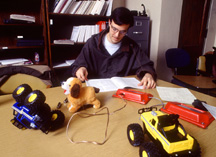 Purdue News
Purdue News
 Purdue News
Purdue News
February 1997

|
"It's a good experience and different from my other classes," says Ross Thompson, an electrical and computer engineering senior from Brownsburg who's in his fifth semester of working on the project and will graduate in May. "It's the way real-world engineering projects are done."
In addition to the homelessness data base, other EPICS projects include designing computer-controlled toys for children with disabilities and developing an automatic locker device to help a middle-school student with a disability who has trouble opening her locker manually.
EPICS involves teams of sophomore, junior and senior engineering students committed to long-term community-service projects that can involve developing mechanical devices and special computer hardware or software. The teams identify technical problems faced by the agencies, or propose ways that technology can create new opportunities for the agencies.
As part of the shared data base, the students have developed an electronic version of a common intake form that the agencies will use to ask clients such questions as number of children in the family, age of family members, race and other information.
"Clients typically have to seek help from a variety of agencies, but with this electronic intake form, they'll have to fill out the application only once," says Joyce Field, chairwoman of the housing committee of the Homelessness Prevention Network. "It'll lessen the time and frustration of dealing with paperwork on the client's behalf. When someone is in an emergency situation, the last thing they need to worry about is filling out duplicate paperwork."
The agencies will benefit from the shared data base because for the first time, Field says, there will be an unduplicated count of the homeless population each year so that the funding sources will understand the dimension of the homeless problem.
"The data base will allow all the agencies to share information on anyone who comes to any of the agencies," she says. "People won't be able to slip through the cracks, and it'll help us better work out a coordinated plan to help these individuals or families become self-sufficient."
The data base also will make it possible for the community to have a better idea of who actually is homeless, Field says.
"The typical stereotype of a homeless person is a single man living under the bridge because of an addiction problem," she says. "But, increasingly, you have working families who are homeless. People often move in and out of homelessness."
Susan Kemp, executive director of Lafayette Transitional Housing Center, which offers shelter and support services for homeless families with children, says she's not aware of any other computer program used to help the homeless on a communitywide basis. Kemp also is chairwoman of the Homelessness Prevention Network.
"I've talked to people around the Midwest and at agencies in Washington, D.C., and there really isn't anything like this data base elsewhere," Kemp says.
At present the students are testing a prototype of the data base at Lafayette Transitional Housing Center. They added another two agencies to the network late last year, and hope to have all nine agencies on the network by the end of spring.
The project has been tricky, says Bharat Parihar, another student working on the data base, because all the agencies need to share certain information such as number of children in the family, but certain agencies such as those dealing with substance or domestic abuse need to keep other information confidential.
Parihar, from Nairobi, Kenya, was with the project since it began three semesters ago. He graduated in December with a degree in electrical and computer engineering .
In addition to providing a community service, students earn academic credit through EPICS. Many, like Thompson and Parihar, return the next semester to continue working with a particular project.
Leah H. Jamieson, one of the co-founders of the program and professor of electrical and computer engineering, says the entire EPICS program helps undergraduate engineering students apply their technical skills to provide a community service and to learn how to work in teams.
"Undergraduate students in engineering need to have more than just a solid technical background -- they'll be expected to work with people of many different backgrounds to achieve goals," Jamieson says. "It's important to help them develop these skills.
"The project with the Homelessness Prevention Network is a perfect example of the impact that the synergy between Purdue groups and the community can have.
"We believe EPICS has the potential to become a nationwide program that brings together college students, community service agencies and industrial partners. In addition to bringing in other than engineering students at Purdue to work on projects, we'd like to export the program to at least five other universities and some cities by the year 2000."
Already the University of Delaware and Iowa State University plan to adopt an EPICS program this spring, she says.
EPICS, which began in fall 1995, involves approximately 65 engineering students. It is supported by the National Science Foundation, the U.S. Department of Education's Fund for the Improvement of Postsecondary Education, Texas Instruments, Xilinx Inc. and Comdisco, as well as several offices at Purdue.
The EPICS Web page can be found at https://purcell.ecn.purdue.edu/~epics
ler/jamieson.EPICS/9701f30
Sources: Leah Jamieson, (765) 494-3653; e-mail, lhj@ecn.purdue.edu
Ross Thompson, (765) 746-2023; e-mail, rbthomps@ecn.purdue.edu
Bharat Parihar, (765) 743-7638; e-mail, bharat@ecn.purdue.edu
Joyce Field, (765) 463-1746; e-mail, jfield@nlci.com
Susan Kemp, (765) 423-4880
Purdue News Service: (765) 494-2096; e-mail, purduenews@purdue.edu
Photo Caption:
Color photo, electronic transmission, and Web and ftp download available. Photo ID:
Jamieson/EPICS
Download here